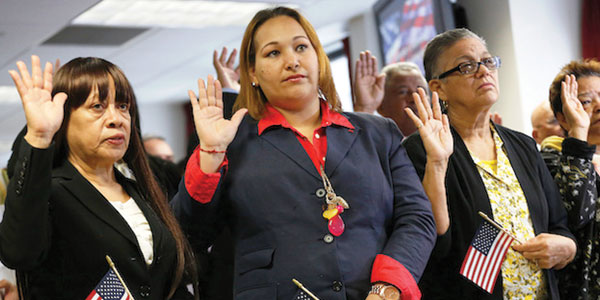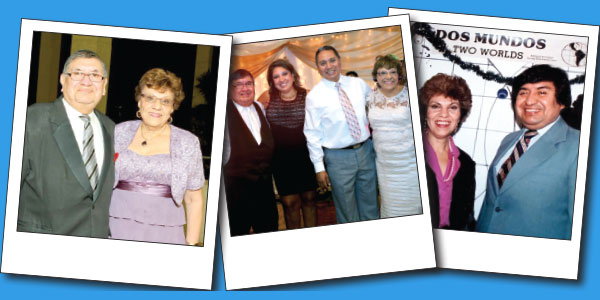
En los próximos meses podría volverse más costoso solicitar la ciudadanía de Estados Unidos. En el mes de mayo, el Departamento de Servicios de Ciudadanía e Inmigración de Estados Unidos (USCIS, por sus siglas en inglés) propuso una nueva regla que aumentaría los costos de solicitud a un promedio del más del 20 por ciento. El aumento podría entrar en vigencia ya en septiembre.
El 4 de mayo el Departamento de Seguridad Nacional (DHS, por sus siglas en inglés), la agencia matriz de USCIS, entregó la regla propuesta en el Registro Federal, estableciendo un período público para comentarios, el cual sigue hasta el 5 de julio. El DHS analizará los comentarios antes de decidir la regla y establecer la fecha de efectividad, posiblemente más adelante este año.
«Seis meses pueden ser una guía muy buena pero no necesariamente representativa. Tomará un tiempo para que ellos revisen todos los comentarios y hagan los cambios necesarios. Estoy casi segura que será hasta después del primero de septiembre», dijo Kate Voigt, directora asociada de enlace para la Asociación Americana de Abogados en Inmigración (AILA, por sus siglas en inglés). biometric
DHS propone aumentar el costo de solicitud para el formulario de naturalización (formulario N-400) de $680 a $725. Ambas cantidades incluirían la cuota biométrica de $85, la cual seguiría igual. Sin embargo, bajo la regla propuesta, algunos inmigrantes tendrían un descuento. Formado dentro de una nueva estructura de costos, está una lista escalonada de cobros basada en los ingresos. Los solicitantes cuyo ingreso familiar esté entre el 150 y 200 por ciento de la Guía Federal de Pobreza pagarían $320, más la cuota biométrica de $85, dando un total de $405. La cuota completa sería perdonada para solicitantes cuyo ingreso familiar se encuentre debajo del 150 por ciento del nivel de pobreza.
No existe una excepción propuesta para los solicitantes de la visa H–B1. Bajo la regla propuesta, el costo aumentaría de $325 a $460. La propuesta completa, incluyendo los costos que se planean y las instrucciones al entregar comentarios sobre los aumentos propuestos, puede encontrarse en línea en https://www.federalregister.gov/articles/2016/05/04/2016-10297/us-citizenship-and-immigration-services-fee-schedule#h-4
La última vez que USCIS aumentó los costos fue en noviembre del 2010. La agencia se mantiene casi por si misma ya que recibe fondos principalmente de los cobros de solicitud que colecta. Pero mantener el costo actual resultaría en un déficit de $560 millones anualmente, reveló la revisión más reciente de la agencia. Aumentar los costos “es necesario para recuperar completamente los costos para los servicios de USCIS y mantener un servicio adecuado”, declaró la agencia.
La Asociación Americana de Abogados de Inmigración está revisando la regla propuesta antes de hacer comentarios, dijo Voigt.
“Estamos acercándonos a los miembros para tener una idea de lo que piensan. Algunos están preocupados, y probablemente haremos comentarios, pero también entendemos la razón por la que USCIS necesita aumentar los costos”, dijo ella.
Los comentarios públicos sobre los aumentos propuestos de USCIS en el 2010 están disponibles en https://www.regulations.gov/#!docketDetail;rpp=100;so=DESC;sb=docId;po=0;D=USCIS-2009-0033 or by simply Googling “Docket ID USCIS 2009-0033.
Los comentarios propuestos podrían afectar los aumentos que se proponen.
“Las agencias tienen que tomar eso en cuenta, pero tiene que existir alguna base para que USCIS ajuste los costos. No puede ser solamente porque la gente quiera que los costos sean diferentes”, dijo Voigt.
_____________________________________________________________________________________________________________________
Fee hike planned for immigration papers
By Edie R. Lambert
It could become more expensive in the coming months to apply for United States citizenship. In May, U.S. Citizenship and Immigration Services (USCIS) proposed a new rule that would raise filing fees by an average of more than 20 percent. The increase could take effect as early as September.
The Department of Homeland Security, the USCIS parent agency, filed the proposed rule in the Federal Register on May 4, setting up a public comment period, which runs through July 5. The DHS will consider the comments before finalizing the rule and setting the effective date, possibly later this year.
“Six months can be a very good guide but not necessarily indicative. It will take a while for them to review all the comments and make necessary changes. I would bet that it would be after the first of September,” said Kate Voigt, the American Immigration Lawyers Association’s (AILA) associate director of liaison.
DHS proposes raising the application fee for naturalization (Form N-400) from $680 to $725. Both figures include the $85 biometrics fee, which would remain unchanged. Under the proposed rule, however, some immigrants would get a break. Built into the new fee structure is an income-based tiered fee schedule. Applicants with family income between 150 and 200 percent of the Federal Poverty Guidelines would pay $320, plus the $85 biometrics fee for a total of $405. The entire fee would be waived for applicants with family income at or below 150 percent of the poverty level.
There’s no fee waiver proposed for H-B1 visa applicants. Under the proposed rule, the fee will increase from $325 to $460. The entire proposal, including planned fees and instructions on submitting comments on the proposed fee increases may be found online at https://www.federalregister.gov/articles/2016/05/04/2016-10297/us-citizenship-and-immigration-services-fee-schedule#h-4.
USCIS last raised fees in November 2010. The agency pays most of its own way. It’s funded largely by the filing fees it collects. But maintaining the current fee schedule would result in an annual $560 million shortfall, the agency’s most recent review revealed. Increasing the fees “is necessary to fully recover costs for USCIS services and to maintain adequate service,” the agency stated.
The American Immigration Lawyers Association is reviewing the proposed rule before commenting, Voigt said.
“We’re reaching out to members to get a sense of what they think. Some are concerned, and we’ll likely be commenting, but we also understand why they (USCIS) need to raise fees,” she said.
Public comments on the USCS proposed fee hikes in 2010 are available online at https://www.regulations.gov/#!docketDetail;rpp=100;so=DESC;sb=docId;po=0;D=USCIS-2009-0033 or by simply Googling “Docket ID USCIS 2009-0033.”
Public comments could affect the proposed fee increases.
“Agencies have to take those into account, but there has to be some basis for USCIS to adjust the fees. It can’t just be because people want the fees different,” Voigt said.










